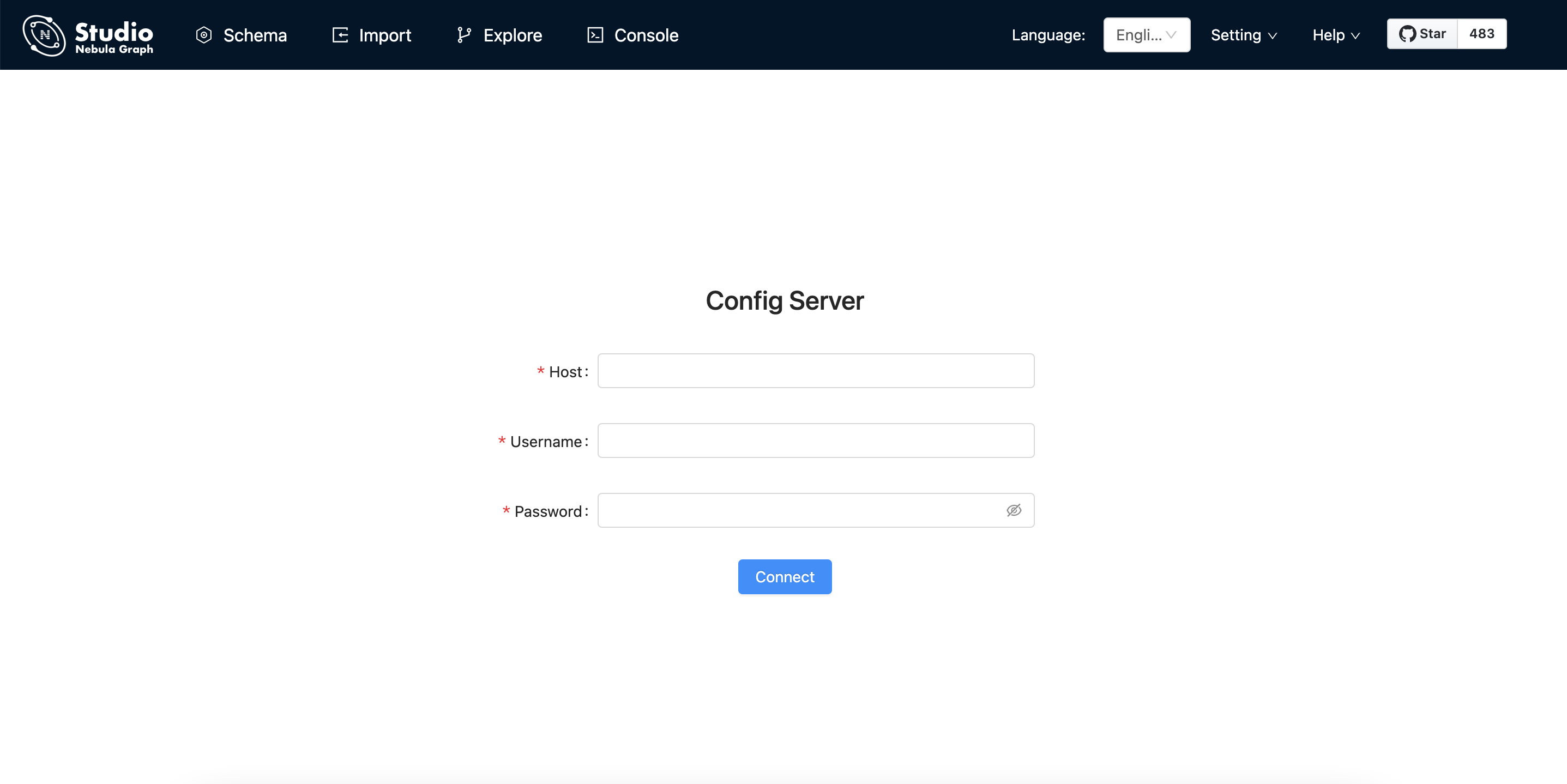Deploy Studio¶
This topic describes how to deploy Studio locally by Docker, RPM, and tar package.
Note
You can also try some functions online in Studio.
RPM-based Studio¶
Prerequisites¶
Before you deploy RPM-based Studio, you must confirm that:
- The NebulaGraph services are deployed and started. For more information, see NebulaGraph Database Manual.
-
If your Linux distribution is CentOS, install
lsofand Node.js of versions above v10.16.0+.Note
nodeandnpmshould be installed in/usr/bin/directory. Avoid the situation that the node command cannot be found during RPM installation. For example, the default directory of nodejs12 is in/opt/rh/rh-nodejs12, you can use following commands to build soft link:$ sudo ln -s /opt/rh/rh-nodejs12/root/usr/bin/node /usr/bin/node $ sudo ln -s /opt/rh/rh-nodejs12/root/usr/bin/npm /usr/bin/npm
-
Before the installation starts, the following ports are not occupied.
Port Description 7001 Web service provided by Studio. 8080 HTTP service provided by Nebula HTTP Gateway.
Install¶
-
Select and download the RPM package according to your needs. It is recommended to select the latest version. Common links are as follows:
Installation package Checksum Nebula version nebula-graph-studio-3.1.1-1.x86_64.rpm nebula-graph-studio-3.1.1-1.x86_64.rpm.sha256 v2.6.2 -
Use
sudo rpm -i <rpm>to install RPM package.For example, install Studio 3.1.1, use the following command:
sudo rpm -i nebula-graph-studio-3.1.1-1.x86_64.rpmWhen the screen returns the following message, it means that the PRM-based Studio has been successfully started.
egg started on http://0.0.0.0:7001 nohup: Add the output to "nohup.out" -
When Docker-based Studio is started, use
http://ip address:7001to get access to Studio.Note
Run
ifconfigoripconfigto get the IP address of the machine where Docker-based Studio is running. On the machine running Docker-based Studio, you can usehttp://localhost:7001to get access to Studio.If you can see the Config Server page on the browser, Docker-based Studio is started successfully.

Uninstall¶
Users can uninstall Studio using the following command:
sudo rpm -e nebula-graph-studio-3.1.1-1.x86_64
Exception handling¶
If the automatic start fails during the installation process or you want to manually start or stop the service, use the following command:
- Start the service manually
bash /usr/local/nebula-graph-studio/scripts/rpm/start.sh
- Stop the service manually
bash /usr/local/nebula-graph-studio/scripts/rpm/stop.sh
If you encounter an error bind EADDRINUSE 0.0.0.0:7001 when starting the service, you can use the following command to check port 7001 usage.
lsof -i:7001
If the port is occupied and the process on that port cannot be terminated, you can use the following command to change Studio service port and restart the service.
//Open the configuration file
$ vi config/config.default.js
//Change the port number
...
config.cluster = {
listen: {
port: 7001, // Modify this port number and change it to any one currently available
hostname: '0.0.0.0',
},
};
...
//Restart npm
$ npm run start
tar-based Studio¶
Prerequisites¶
Before you deploy tar-based Studio , you must do a check of these:
- The NebulaGraph services are deployed and started. For more information, see NebulaGraph Database Manual.
-
The Linux distribution is CentOS, installed
lsofand Node.js of version above v10.16.0+.Note
nodeandnpmshould be installed in/usr/bin/directory. Avoid the situation that the node command cannot be found during RPM installation. For example, the default directory of nodejs12 is in/opt/rh/rh-nodejs12, you can use following commands to build soft link:$ sudo ln -s /opt/rh/rh-nodejs12/root/usr/bin/node /usr/bin/node $ sudo ln -s /opt/rh/rh-nodejs12/root/usr/bin/npm /usr/bin/npm
-
Before the installation starts, the following ports are not occupied.
Port Description 7001 Web service provided by Studio 8080 Nebula-http-gateway, Client's HTTP service
Install¶
-
Select and download the tar package according to your needs. It is recommended to select the latest version. Common links are as follows:
Installation package Studio version nebula-graph-studio-3.1.1-1.x86_64.tar.gz 3.1.1 -
Use
tar -xvfto decompress the tar package.tar -xvf nebula-graph-studio-3.1.1-1.x86_64.tar.gz
Procedure¶
Note
The root directory nebula-graph-studio has two installation packages: nebula-graph-studio and nebula-importer. You need to deploy and start the services separately on the same machine to complete the deployment of Studio.
-
Deploy and start nebula-http-gateway.
$ cd nebula-http-gateway $ nohup ./nebula-httpd & -
Deploy and start nebula-graph-studio.
$ cd nebula-graph-studio $ npm run startCaution
Studio 2.6.2 version is not dependent on nebula-importer, so the installation and deployment procedure is different from Studio v3.0.0.
-
When tar-based Studio is started, use
http://ip address:7001to get access to Studio.Note
Run
ifconfigoripconfigto get the IP address of the machine where Docker-based Studio is running. On the machine running Docker-based Studio, you can usehttp://localhost:7001to get access to Studio.If you can see the Config Server page on the browser, Docker-based Studio is started successfully.

Stop Service¶
You can use kill pid to stop the service:
$ kill $(lsof -t -i :8080) # stop nebula-http-gateway
$ cd nebula-graph-studio
$ npm run stop # stop nebula-graph-studio
Docker-based Studio¶
Prerequisites¶
Before you deploy Docker-based Studio, you must do a check of these:
- The NebulaGraph services are deployed and started. For more information, see NebulaGraph Database Manual.
- On the machine where Studio will run, Docker Compose is installed and started. For more information, see Docker Compose Documentation.
-
Before the installation starts, the following ports are not occupied.
Port Description 7001 Web service provided by Studio 8080 Nebula-http-gateway, Client's HTTP service
Procedure¶
To deploy and start Docker-based Studio, run the following commands. Here we use NebulaGraph v2.6.2 for demonstration:
-
Download the configuration files for the deployment.
Installation package NebulaGraph version nebula-graph-studio-v3.1.1.tar.gz v2.6.2 -
Create the
nebula-graph-studio-v3directory and decompress the installation package to the directory.mkdir nebula-graph-studio-v3 && tar -zxvf nebula-graph-studio-v3.gz -C nebula-graph-studio-v3 -
Change to the
nebula-graph-studio-v3directory.cd nebula-graph-studio-v3 -
Pull the Docker image of Studio.
docker-compose pull -
Build and start Docker-based Studio. In this command,
-dis to run the containers in the background.docker-compose up -dIf these lines are returned, Docker-based Studio v3.x is deployed and started.
Creating docker_client_1 ... done Creating docker_web_1 ... done Creating docker_nginx_1 ... done -
When Docker-based Studio is started, use
http://ip address:7001to get access to Studio.Note
Run
ifconfigoripconfigto get the IP address of the machine where Docker-based Studio is running. On the machine running Docker-based Studio, you can usehttp://localhost:7001to get access to Studio.If you can see the Config Server page on the browser, Docker-based Studio is started successfully.

Next to do¶
On the Config Server page, connect Docker-based Studio to NebulaGraph. For more information, see Connect to NebulaGraph.